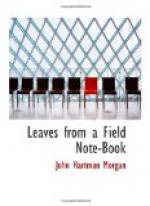rabbits by the ears from large sacks, like a conjuror,
and holding out live and plaintive fowls for sensual
examination by pensive housewives. Also it has
a town-hall in which I once witnessed the trial by
court-martial of a second-lieutenant in the R.A.M.C.
for ribaldry in his cups and conduct unbecoming an
officer and a gentleman—a spectacle as melancholy
as it is rare, and of which the less said the better.
It has a church with some lurid glass of indifferent
quality, and (if I remember rightly) a curious dovecote
of a tower. The transepts are hemmed in by shops
and warehouses. To the mediaevalist there is
nothing strange in such neighbourliness of the world
and the Church. The great French churches of
the Middle Ages—witness Notre Dame d’Amiens
with its inviting ambulatory—were places
of municipal debate, and their sculpture was, to borrow
the bold metaphor of Viollet-le-Duc, a political “liberty
of speech” at a time when the chisel of the
sculptor might say what the pen of the scrivener dared
not, for fear of the common hangman, express.
Bethune is not the only place where I have seen shops
coddling churches, and the conjunction was originally
less impertinent than it now seems. It was not
that the Church was profaned, but that the world was
consecrated; honest burgesses trading under the very
shadow of the flying buttresses were reminded that
usury was a sin, and that to charge a “just
price” was the beginning of justification by
works. But I have not observed that the shopkeepers
of Bethune now entertain any very mediaeval compunction
about charging the British soldier an unjust price.
Armentieres is on the high road to Lille, but at present
there is no thoroughfare. It’s a dispiriting
town, given over to industrial pursuits, and approached
by rows of mean little cottages such as you may see
on the slopes of the mining valleys of South Wales.
Two things stand out in my memory—one,
the spectacle of a corporal being tried for his life
in the Town Hall by a court-martial—there
had been a quarrel over a girl in billets and he had
shot his comrade; the other the sight of a regiment
of Canadians ("Princess Pat’s,” I believe),
drawn up in the square for parade one winter afternoon
before they went into the trenches for the first time.
And a very gallant and hefty body of men they were.
Poperinghe is a dismal place, and to be avoided.
Hazebrouck is not without some pretentiousness.
It has the largest place of any of them, with
a town-hall of imposing appearance, but something
of a whited sepulchre for all that. I remember
calling on a civilian dignitary there—I
forget what he was; he sat in a long narrow corridor-like
room, all the windows were hermetically sealed, a
gas-stove burnt pungently, some fifty people smoked
cigarettes, and at intervals the dignitary spat upon
the floor and then shuffled his foot over the spot
as a concession to public hygiene. Therefore I
did not tarry. The precincts of the railway-station




